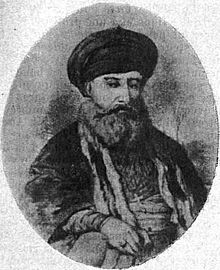Yohannan VIII Hormizd | |
|---|---|
| Patriarch of Babylon of the Chaldeans | |
 | |
| Church | Chaldean Catholic Church |
| Archdiocese | Babylon |
| See | Babylon of the Chaldeans |
| Installed | 5 July 1830 |
| Term ended | 1838 |
| Predecessor | Joseph IV as Patriarch of Chaldean Catholic Church. Eliya XII as Patriarch belonging to the Eliya line based in the Monastery of Rabban Hormizd. |
| Successor | Nicholas I Zayʿa |
| Orders | |
| Consecration | 22 May 1776 (Bishop) by Patriarch Eliya XI |
| Personal details | |
| Born | Yohannan Hormizd 1760 |
| Died | 16 August 1838 (aged 77–78) Mosul |
| Residence | Iraq, Ottoman Empire |
Yohannan VIII Hormizd (often referred to by European missionaries as John Hormez or Hanna Hormizd) (1760–1838) was the last hereditary patriarch of the Eliya line of the Church of the East and the first patriarch of a united Chaldean Church. After the death of his uncle Eliya XI in 1778, he claimed the patriarchal throne in 1780 and made a Catholic profession of faith. In 1783, he was recognized by the Vatican as patriarchal administrator and archbishop of Mosul. His career as patriarchal administrator was controversial, and was marked by a series of conflicts with his own bishops and also with the Vatican. Suspended from his functions in 1812 and again in 1818, he was reinstated by the Vatican in 1828. In 1830, following the death of the Amid patriarchal administrator Augustine Hindi, he was recognised by the Vatican as patriarch of Babylon of the Chaldeans and the Mosul and Amid patriarchates were united under his leadership. This event marked the birth of the since unbroken patriarchal line of the Chaldean Catholic Church. Yohannan Hormizd died in 1838 and his successor Nicholas I Zayʿa was chosen by the Vatican, ending the centuries-old practice of hereditary succession.[1][2]
- ^ Wilmshurst 2000, p. 29-30.
- ^ Baum & Winkler 2003, p. 120-122.